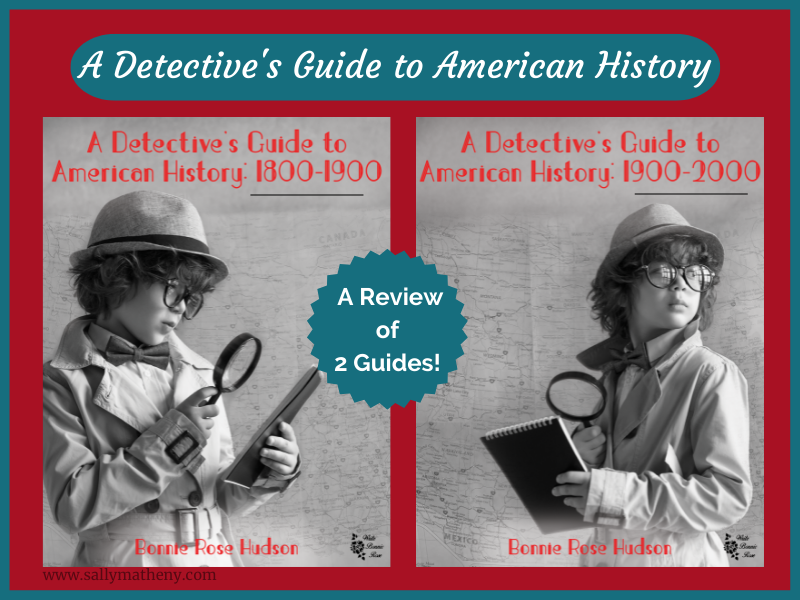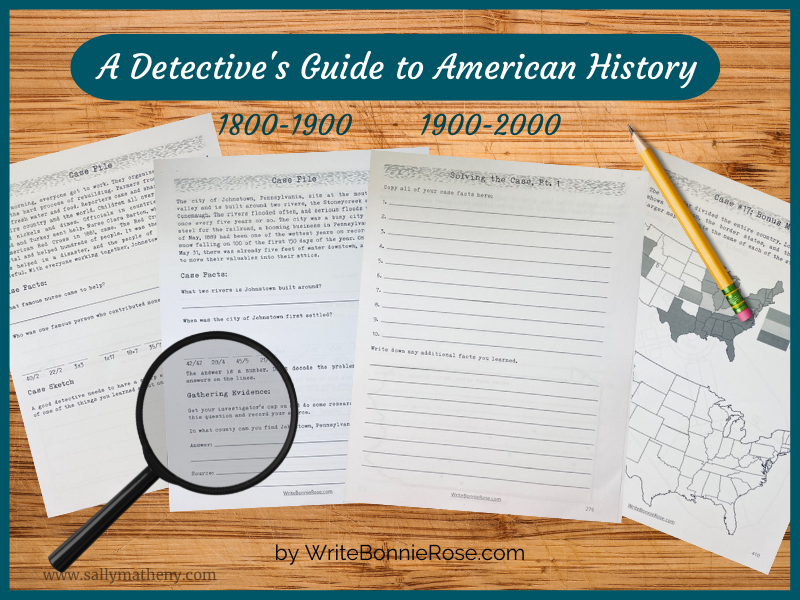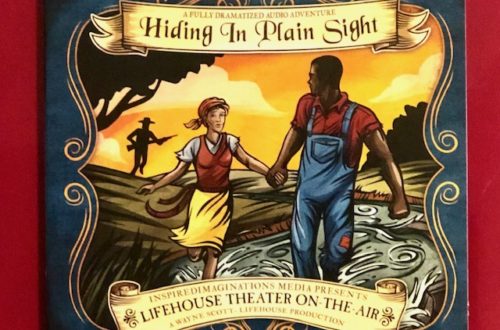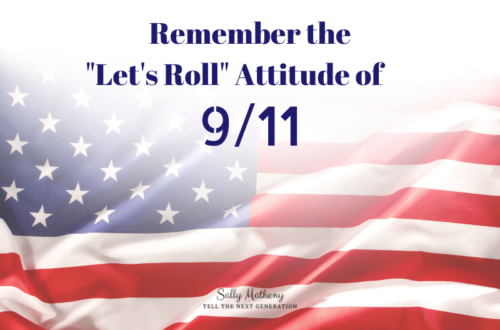
A Detective’s Guide to American History {Review of 2!}
Are you searching for fun ways to teach your children about key people and events in American history? Investigate this review of two resources–A Detective’s Guide to American History: 1800 to 1900 and A Detective’s Guide to American History: 1900 to 2000.
Both guides are written for elementary students. The product desciption doesn’t mention a specific age, but I’m thinking it is best suited for 3rd-5th graders. However, the content is adaptable. I learned several new things, and I’m well past fifth grade! These guides can easily be used to refresh the memories of older students.
The Author – Bonnie Rose Hudson
Bonnie Rose Hudson, author of the children’s book, The Hidden Village, worked for many years at SchoolhouseTeachers.com as a writer, educator, editor, and director. Hudson continues to write and create wonderful curriculum.
You’ll find numerous educational and inspirational resources on her website, WriteBonnieRose.com.
Her products are offered as digital downloads or e-books. Therefore, there are no shipping and handling fees. The terms for the use of the products are very generous: “For use by a family, this unit can be printed and copied as many times as needed. Classroom teachers may reproduce one copy for each student in his or her class. Members of co-ops or workshops may reproduce one copy for up to fifteen children.”
Much to my delight, Bonnie Rose has an abundant supply of products regarding American history. Several of her resources for teaching about the U.S. Government and the election process I’ve reviewed here on the blog.
But, today we’re highlighting Hudson’s two Detective Guides to American History!
The Similarities Between the 2 Detective’s Guides to American History
The format is the same for both A Detective’s Guide to American History: 1800 to 1900 and A Detective’s Guide to American History: 1900 to 2000.
Hudson incorporated a fun theme of detective work for students. The first vocabulary word they’ll learn, if they don’t know it already, is the French word, dossier (“daa-see-ay”). How intelligent they’ll feel when they learn this is a fancy word for a collection of information about a specific person or event.
Each lesson is called a case file. It includes five short paragraphs. Each paragraph has its own page so students could read one paragraph a day, or more, if preferred.
After each paragraph there are two questions. The first question is based on their reading comprehension of the paragraph. The second question requires them to use the provided decoding wheel to figure out the answer.
Secret codes! How cool is that?
Some of the answers will involve addition, subtraction, multiplication, and division.
Each lesson includes an activity utilizing boldfaced vocabulary words. Also, the “Case Sketch” provides an opportunity for drawing something related to the lesson.
Basic map skills are put into use throughout each Detective Guide. But Hudson also provides bonus activities with more in-depth map work. Students will need to access maps, but most of the activities are easy to do. The one I found most challenging was the one asking students to draw an eleven-pointed star. I need to Google how to do that!
In addition, there are optional “Gathering Evidence” assignments where students have an opportunity to develop research skills. They’ll need to use other resources such as libraries or the internet to find the answers for these.
Finally, there is a “Solving the Case” activity where students record what they’ve learned.
There are ten optional lessons, called “Dossiers.” These focus on a specific person, one from each decade. The dossiers are shorter and do not include vocabulary or map work.
And, yes, an answer key is provided for everything, but not for the map activities.

The Differences Between the Detective’s Guides
The two Detective’s Guides differ in illustrations. Each case study features one unique, high-quality black-and-white photo of its topic.
Also, the two detective guides differ in the time periods and topics covered.
Topics in the 1800 – 1900 American History Guide
The subjects covered in the 1800-1900 guide encompass 445 pages! You can see the contents in the photo below.

Topics covered in the 1900 – 2000 American History Guide
The topics covered in the 1900 – 2000 guide fill 532 pages! They cover:
- Wright Brothers
- Panama Canal
- San Francisco Earthquake of 1906
- Titanic
- World War I
- Prohibition
- Nineteenth Amendment
- Charles Lindbergh’s Transatlantic Flight
- Mount Rushmore
- Great Depression
- Empire State Building
- Roosevelt and the New Deal
- Dust Bowl
- Hindenburg
- Pearl Harbor
- D-Day
- End of World War II
- Korean War
- Puerto Rico, Alaska and Hawaii
- Cuban Missile Crisis
- Apollo 11 and Apollo 13
- America’s Bicentennial
- Miracle on Ice
- Mount St. Helens
- Space Shuttle Program
- Exxon Valdez Oil Spill
- Hubble Space Telescope and the International Space Station
The optional units cover Milton Hershey, Henry Ford, George Washington Carver, Jim Thorpe, Duke Ellington, Babe Ruth, Albert Einstein, Jesse Owens, Code Talkers, Jackie Robinson, Virginia Apgar, Ray Kroc, Katherine Johnson, Martin Luther King, Jr., E. B. White, Hank Aaron, Willem Kolff, Ronald Reagan, Norman Schwarzkopf, and Clarence Thomas.
Bonus Info
I noticed there are additional resource packs available for both of these American History guides on Hudson’s website. I checked a few of the sample pages out. So far, my favorite is the “Additional Resources” bundle. It looks like it has a lot of fun activities included!
Plus, Hudson is running a 50% off sale for both of these guides and the additional resources for them through July 16, 2022. Get more info about all of these items and the sale here. (This is not an affiliate link.)
What I Like
There are several things I really like about these two Guides. Hudson made learning history intriguing and fun. Even the typewriter font she chose to use adds to the theme.
I like how key people and events are introduced in meaty bite-size chunks. Also, I enjoy the case studies which are not about familiar topics. I love learning about captivating tidbits of history, especially those I don’t remember being in the history textbooks of my childhood.
For example, the case study about the flood in Johnstown, Pennsylvania. I think children will absorb much from this story regardless of whether they live in PA or that the event took place in 1889. Besides the huge event that took place, and that Clara Barton and the Red Cross were involved, children will also learn about the value of communication, responsibility, and compassion.
These two Guides to American History hook readers from the first paragraph. Instead of working though one paragraph a day, I think students will be begging for more.
*****
Just out of curiosity, what’s one of your favorite time periods to study in American history?

A freelance writer, Sally Matheny’s writing is published in worldwide, national, regional, online and print publications including Appleseeds, Clubhouse Jr., Homeschooling Today, and The Old Schoolhouse.
As a writer, blogger, and speaker, Sally encourages parents to live victorious and to courageously tell the next generation wondrous things. Connect with her on several social media sites, but her favorite hangouts are at SallyMatheny.com and Pinterest.





4 Comments
Kathy
These sound like books to really capture kids’ interest! I hadn’t heard of them before. Thanks for reviewing them, Sally.
Sally Matheny
Hi, Kathy. You should check out her website. She offers lots of intriguing resources! 🙂
Gayle Veitenheimer
Sounds fun!
Sally Matheny
Bonnie Rose Hudson has a knack for making learning fun! 🙂